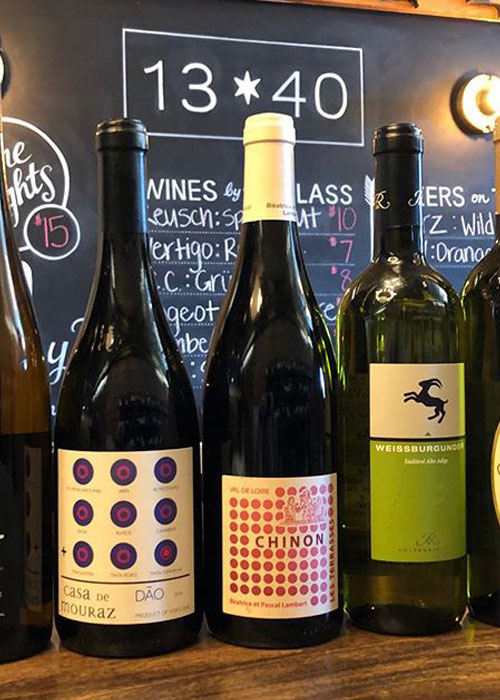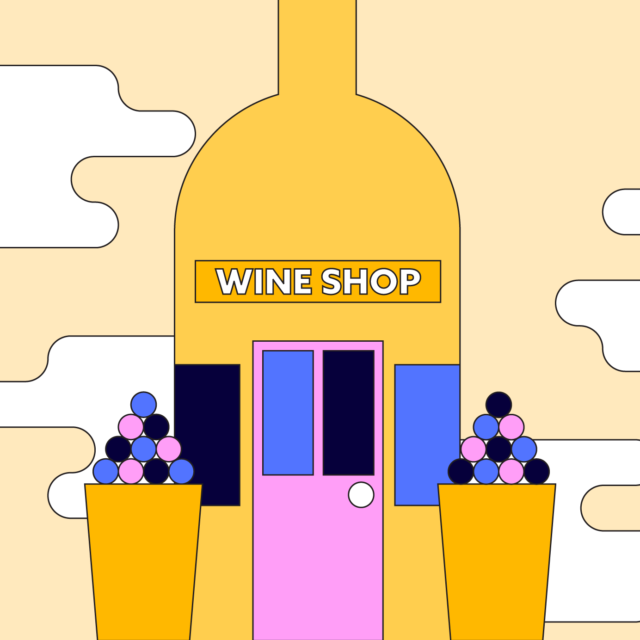Sommelier, wine consultant, and educator Derrick Westbrook recently partnered with friend Cody Berek to redesign a Chicago wine shop formerly known as Madison Vine Wines. They wanted the new iteration of the store, now called 1340 BWS, to appeal to as many people as possible without losing the essence of its community.
“The current layout of the store is in the style of a slashy,” Westbrook explains. “Here in Chicago, ‘slashies’ are liquor stores that also serve as a bar. We have a wall of wine on dark iron shelves with exposed brick as the backdrop. On the opposite wall is our reclaimed wooden wine bar shaped much like a hockey stick to accentuate the flow of the space. Next to the bar, there are about 20 feet of fridges to house wine, sake, cider, and beers that we sell in singles.”
Westbrook is one of several wine professionals rethinking retail. By pairing local influences with intuitive design, they hope to take away the guesswork and grandeur from the experience. After all, walking into a wine shop can be overwhelming for some drinkers, thanks to countless varietals, esoteric layouts, and an overarching fear of saying or doing the wrong thing. Fortunately, by understanding the ways most wine shops organize their wares, any shopper can browse and buy with confidence.
Wine stores with tasting licenses, like the one that allows 1340 BWS to pour alcohol on-site, are ideal for apprehensive shoppers, says Larissa Dubose, a sommelier, wine sales manager, and founder of The Lotus & The Vines. It gives consumers the chance to try things before they buy, and fosters natural conversations among staff and guests.
Whether you’re sipping at an in-store bar or walking through the aisles, that interaction is key. “The best way you can learn your way around your local wine shop is by engaging with the staff,” Dubose says. “Many people are intimidated to ask questions because they don’t want to feel embarrassed, but the staff is specifically there to help you find what you’re looking for.”
 When it comes to the arrangement of wine bottles in the shop, Westbrook favors geographic organization. “At 1340, we’ve organized the shop by region because we want people to venture away from thinking about varietals, but rather focus on styles and regions,” he says. “We use the wine wall to empower our customers to become more confident in choosing and exploring the world of wine.”
When it comes to the arrangement of wine bottles in the shop, Westbrook favors geographic organization. “At 1340, we’ve organized the shop by region because we want people to venture away from thinking about varietals, but rather focus on styles and regions,” he says. “We use the wine wall to empower our customers to become more confident in choosing and exploring the world of wine.”
Dubose agrees, noting she has stumbled across wines that she may not have otherwise tried, like a Falanghina from Italy, while perusing geographically organized shelves.
While geographic organization does require some entry-level wine knowledge to navigate — if you’re looking for a Douro Valley red, for example, you’ll need to know to look in Portugal — it’s considerably more intuitive than shopping by varietal. After all, not everyone at the wine store will immediately identify Sancerre as part of France, but fewer still are likely to know offhand it’s the same thing as Sauvignon Blanc.
Additionally, organizing wines by region can help shoppers hosting or attending dinner parties come up with pairing ideas, following the “what grows together goes together” adage.
Other shops are laid out according to sensory perceptions, such as sweetness or style. Dubose mentions the Urban Grape in Boston, which uses progressive shelving. “In this technique, they order their wines by body rather than varietal or region,” she explains.
 Cathy Huyghe describes this shopping experience as akin to “reading a book” in an article in Food52. “On the left are lighter-bodied white wines such as Pinot Grigio and Sauvignon Blanc,” Huyghe writes. “Next, further to the right, are fuller-bodied and fruitier whites, such as Chardonnay and Riesling. Gradually you move into lighter red wines such as Pinot Noir. And eventually, furthest to the right, you come to the heavier, fuller-bodied reds like Cabernet Sauvignon.”
Cathy Huyghe describes this shopping experience as akin to “reading a book” in an article in Food52. “On the left are lighter-bodied white wines such as Pinot Grigio and Sauvignon Blanc,” Huyghe writes. “Next, further to the right, are fuller-bodied and fruitier whites, such as Chardonnay and Riesling. Gradually you move into lighter red wines such as Pinot Noir. And eventually, furthest to the right, you come to the heavier, fuller-bodied reds like Cabernet Sauvignon.”
This is certainly useful to those with a working knowledge of wine and food, but it is also subjective. Palates are highly individualized, and so one person’s medium-bodied wine could seem heavy to someone else.
The one area that never leaves room for interpretation is price. Good wine shops stock bottles at an array of price points, and make those numbers easy to find.
“Show the price on the shelf. The eye goes to a cool label, then it goes down to the price,” says Chrishon Lampley, negociant and creator and owner of Love Cork Screw. “If a bottle is in a range that’s affordable for you, you’ll be more likely to grab the one you’re attracted to the most.”
